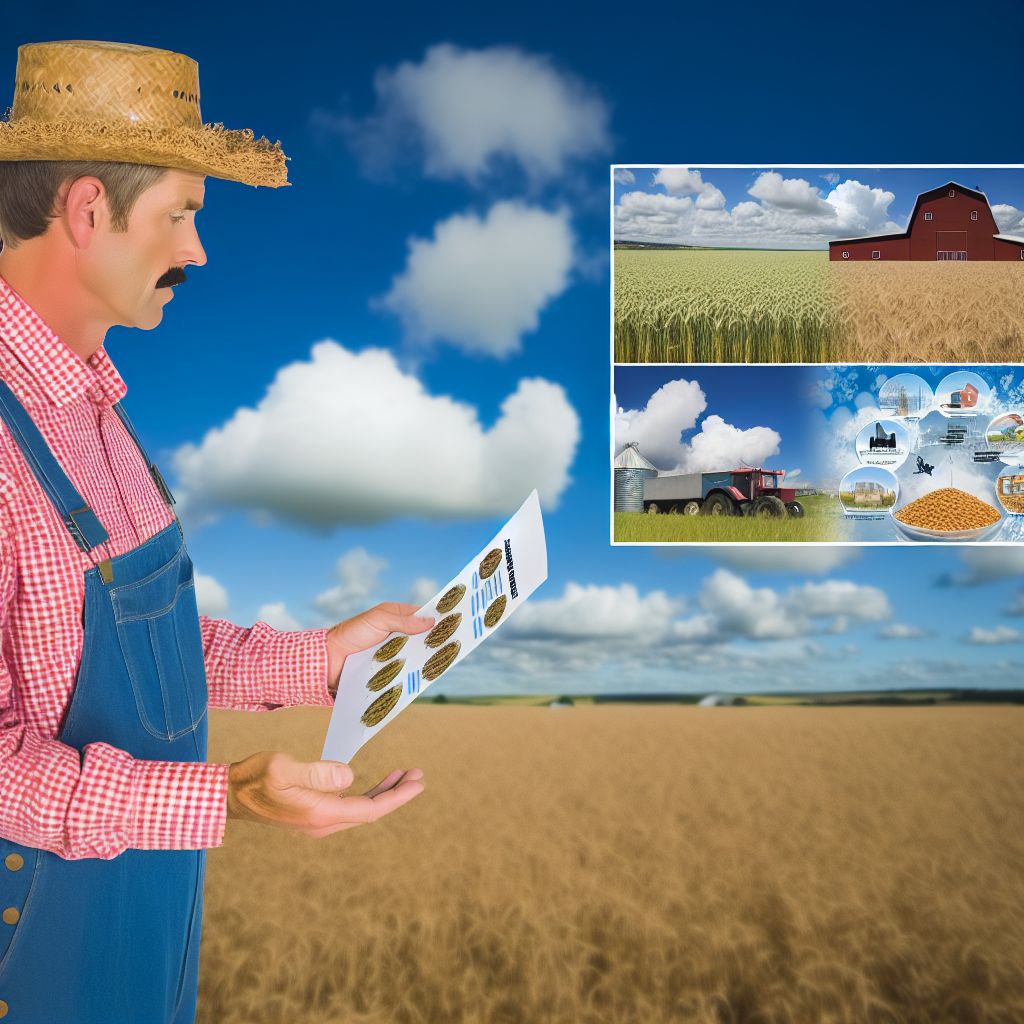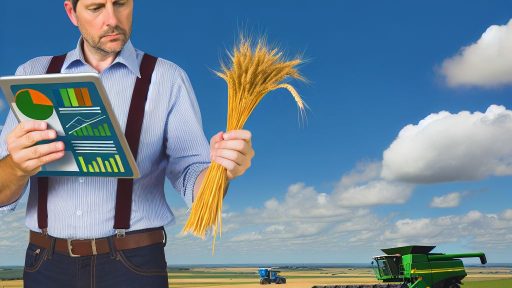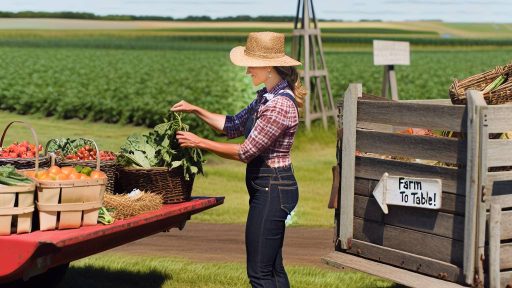Introduction to Crop Insurance and Comprehensive Farm Insurance
Farmers face various risks each growing season.
Understanding insurance options is crucial for their protection.
Two primary types of insurance are crop insurance and comprehensive farm insurance.
Understanding Crop Insurance
Crop insurance protects farmers against losses from natural disasters.
It primarily covers loss of crops due to events like droughts or floods.
This insurance allows farmers to maintain financial stability.
Additionally, crop insurance can be tailored to specific crops.
Farmers may choose between multiple policy options.
- Actual Production History (APH) insurance
- Revenue protection insurance
- Area-based insurance options
Overview of Comprehensive Farm Insurance
Comprehensive farm insurance covers a broader range of risks.
It not only protects crops but also equipment, livestock, and structures.
This type of insurance provides a holistic approach to risk management.
Farmers can benefit from coverage against theft or fire incidents.
Comprehensive policies often include liability protection as well.
Comparing Crop and Comprehensive Farm Insurance
When comparing these insurance types, consider your specific needs.
Crop insurance is ideal for those primarily focused on crop protection.
Transform Your Agribusiness
Unlock your farm's potential with expert advice tailored to your needs. Get actionable steps that drive real results.
Get StartedMeanwhile, comprehensive insurance suits farmers seeking extensive coverage.
Evaluate potential risks in your operations before deciding.
Understanding Crop Insurance
Overview of Crop Insurance
Crop insurance protects farmers against loss of income due to unexpected events.
These events include natural disasters, droughts, and pest infestations.
Farmers can select policies that best fit their needs and crops.
Types of Crop Insurance
Two primary types of crop insurance exist: federal and private insurance.
Federal crop insurance provides coverage through the Risk Management Agency (RMA).
Private crop insurance companies offer additional options and flexibility.
Multi-Peril Crop Insurance (MPCI)
MPCI covers various risks that can damage crops.
Farmers can receive compensation for losses from unforeseen events.
This type of insurance helps stabilize farming income during tough times.
Revenue Protection Insurance
This approach offers farmers protection against falling prices and yield losses.
It ensures revenue remains sufficient under adverse conditions.
Farmers can customize this to match their business model and financial goals.
Benefits of Crop Insurance
Crop insurance offers critical financial security for farmers.
It helps manage risks associated with fluctuating market conditions.
Insured farmers can plan ahead with confidence and peace of mind.
Access to Credit
Many lenders require crop insurance before granting loans.
This insurance reassures banks and minimizes their risk exposure.
Supplemental Coverage Option (SCO)
SCO provides additional coverage on top of standard federal insurance.
It helps farmers enhance their protection without excessive costs.
Factors to Consider When Choosing Crop Insurance
Several key factors influence the decision on crop insurance.
These include local climate, crop type, and farm size.
Furthermore, farmers should assess their financial viability and risk tolerance.
Showcase Your Farming Business
Publish your professional farming services profile on our blog for a one-time fee of $200 and reach a dedicated audience of farmers and agribusiness owners.
Publish Your ProfileLocal Climate and Crop Types
Farmers must consider the specific risks associated with their climate.
Crops susceptible to certain pests or diseases might require targeted coverage.
Financial Constraints
Insurance costs can vary widely based on farm operation size.
Farmers should evaluate premiums alongside potential benefits.
Comprehensive Farm Insurance: What It Covers and Its Importance
Understanding Coverage Options
Comprehensive farm insurance offers wide-ranging protection for farmers.
This insurance covers various risks associated with farming operations.
It typically includes coverage for buildings, equipment, and livestock.
In addition, it often protects against natural disasters and theft.
Farmers can choose from different coverage levels based on their needs.
These tailored options help manage farm-specific risks effectively.
The Role of Property Coverage
Property coverage is a cornerstone of comprehensive farm insurance.
This coverage protects all physical assets on the farm.
Buildings and structures are included, such as barns and silos.
Equipment like tractors and irrigation systems are also covered.
As a result, farmers can recover faster from unexpected events.
Liability Protection
Liability protection is crucial for any farming operation.
This coverage protects farmers against third-party claims.
For example, if someone is injured on the property, costs arise.
Furthermore, comprehensive insurance helps cover legal fees and settlements.
Hence, this protection safeguards a farmer’s financial future.
Importance of Crop Coverage
Crop coverage is another vital component of comprehensive insurance.
This coverage protects against crop loss due to various reasons.
Natural disasters like floods and droughts affect crop yields.
Additionally, pests and diseases can significantly damage crops.
Comprehensive insurance helps mitigate these losses efficiently.
Financial Security and Peace of Mind
Comprehensive farm insurance provides essential financial security.
It ensures that farmers can continue operations after a loss.
With coverage in place, they can focus on growing their business.
Moreover, the peace of mind it offers is invaluable for farmers.
Knowing they are protected allows them to make informed decisions.
Choosing the Right Provider
Selecting the right insurance provider is critical for farmers.
Farmers should research different options available in the market.
It is essential to compare policies, premiums, and coverage limits.
Reading customer reviews can also provide valuable insights.
Ultimately, finding a trustworthy provider enhances coverage effectiveness.
Gain More Insights: Benefits of Comprehensive Crop Insurance for Modern Farms
Key Differences Between Crop Insurance and Comprehensive Farm Insurance
Definition of Crop Insurance
Crop insurance is designed to protect farmers against loss of their crops.
It typically covers specific risks such as drought, flood, or pests.
Farmers pay premiums to cover potential yield losses.
This type of insurance helps stabilize farmers’ income during tough seasons.
Showcase Your Farming Business
Publish your professional farming services profile on our blog for a one-time fee of $200 and reach a dedicated audience of farmers and agribusiness owners.
Publish Your ProfileDefinition of Comprehensive Farm Insurance
Comprehensive farm insurance offers broader protection than crop insurance.
It includes coverage for farm structures, equipment, and liability.
This insurance safeguards against various risks beyond just crop loss.
It provides peace of mind for the overall farm operations.
Coverage Highlights
Crop insurance mainly focuses on crop yield and revenue risk.
Comprehensive farm insurance covers property damage and liability claims.
Additionally, it can protect tools, livestock, and machinery.
Farm owners choose based on their specific needs and risk factors.
Cost Considerations
Crop insurance costs depend on the crop type and coverage level.
Farmers generally perceive crop insurance as a necessary expense.
Comprehensive farm insurance may have higher premiums due to wider coverage.
Budgeting for each insurance type is essential for farm sustainability.
Subsidies and Support
Crop insurance often receives government subsidies to lower costs for farmers.
This makes it an appealing option for many agricultural producers.
Comprehensive farm insurance lacks similar extensive government support.
Farmers must often bear the full premium costs for this coverage.
Risk Assessment
Choosing between these types of insurance involves assessing risks.
Farmers should evaluate potential crop losses and damage scenarios.
Consulting with insurance professionals can provide valuable insights.
Understanding farm-specific risks helps determine the best coverage option.
Learn More: Adopting Food Safety Standards to Improve Farm Profitability
Factors to Consider When Choosing Between Crop Insurance and Comprehensive Farm Insurance
Understanding Your Needs
Start by evaluating your specific farming operation.
Consider the types of crops you grow.
Each crop may have different insurance requirements.
Furthermore, assess the risks associated with your farm.
Weather patterns, pests, and disease play significant roles.
Types of Coverage Offered
Next, understand the different coverage options available.
Crop insurance mainly focuses on the crops themselves.
It protects against losses from natural disasters or market fluctuations.
On the other hand, comprehensive farm insurance covers wider aspects.
These may include property, liability, and equipment damages.
Cost Considerations
Examine the costs associated with each insurance type.
Crop insurance premiums can vary widely based on crop type.
Comprehensive policies may have higher premiums due to broader coverage.
Additionally, potential deductibles can affect your out-of-pocket expenses.
Legal and Regulatory Factors
Explore any legal requirements for insurance in your state.
Some states mandate specific types of coverage for farms.
Understanding these regulations can help in making informed decisions.
Analyzing Financial Implications
Consider the financial implications of each insurance type.
Evaluate how insurance will impact your farm’s overall budget.
Showcase Your Farming Business
Publish your professional farming services profile on our blog for a one-time fee of $200 and reach a dedicated audience of farmers and agribusiness owners.
Publish Your ProfileYour financial situation can also guide your insurance choice.
Ensure that the policy aligns with your farm’s financial goals.
Availability of Resources
Identify available resources for obtaining insurance.
Research local insurance agents, brokers, and online options.
Gather as much information as possible to compare policies.
This will equip you with the knowledge to make a well-informed choice.
Find Out More: Farm Waste Management Regulations
Cost Analysis of Crop Insurance vs. Comprehensive Farm Insurance
Understanding Crop Insurance Costs
Crop insurance aims to protect farmers from loss due to natural disasters.
This insurance can cover specific crops against various risks.
The cost typically hinges on the type of coverage selected.
Moreover, farmers may need to provide detailed information about their operations.
This analysis can influence premiums significantly.
Insurers assess historical data to determine risk factors.
Premium costs may vary based on crop type and geographical location.
Additionally, farmers must consider deductibles when budgeting for premiums.
Factors Influencing Comprehensive Farm Insurance Costs
Comprehensive farm insurance covers a broader range of risks.
This includes equipment, buildings, and liability protection.
The costs derive from a more extensive assessment of farm assets.
Coverage options can greatly influence pricing.
Insurers will evaluate the value of all insured items within the policy.
Furthermore, the farm’s operational size plays a role in premium rates.
Trends in loss history and claims can affect costs as well.
Farmers should seek multiple quotes to find the best coverage rates.
Comparing Costs and Coverage
While crop insurance focuses on specific agricultural risks, comprehensive policies cover more aspects.
This distinction can lead to varying premium costs.
Farmers must evaluate their unique needs before selecting a policy.
Some may find crop insurance sufficient given their specific crop types.
Others may prefer comprehensive coverage for added peace of mind.
Ultimately, understanding these differences aids in informed decision-making.
Financial Implications and Potential Savings
Farmers should consider the potential return on investment for each type of insurance.
In many cases, crop insurance offers a high benefit-to-cost ratio.
This is especially true during disastrous seasons.
In contrast, comprehensive insurance may provide broader financial security.
However, the premium costs can be higher without guaranteed payouts.
Farmers should analyze their risk exposure carefully.
Creating a budget that factors in potential losses can highlight needs.
Moreover, exploring discounts for bundled insurance policies can offer savings.
Gain More Insights: Comparing Types of Agricultural Insurance for Your Farm

Common Misconceptions About Crop Insurance and Comprehensive Farm Insurance
Understanding Crop Insurance
Many believe that crop insurance covers everything related to crops.
In reality, it primarily protects against yield loss from specific risks.
Showcase Your Farming Business
Publish your professional farming services profile on our blog for a one-time fee of $200 and reach a dedicated audience of farmers and agribusiness owners.
Publish Your ProfileThis can include droughts, floods, or pest infestations.
However, it typically does not cover losses from market fluctuations.
Farmers often misunderstand what types of incidents are covered.
Additionally, the coverage might vary significantly based on the policy.
Farmers should read the fine print to fully understand their coverage.
Exploring Comprehensive Farm Insurance
Comprehensive farm insurance is often confused with crop insurance.
It covers a wider array of incidents beyond just crops.
For instance, it protects buildings, equipment, and liability issues.
Many farmers think it is an unnecessary expense.
However, this insurance can save farmers money in case of losses.
Understanding the breadth of coverage is crucial for farmers.
Misunderstanding of Policy Costs
Some believe that crop insurance is always cheaper than comprehensive farm insurance.
This isn’t always the case, as prices fluctuate based on risk factors.
Farmers should consider long-term benefits versus short-term costs.
Moreover, discounts or benefits may exist for comprehensive policies.
Farmers often overlook these potential savings.
The Importance of Customization
Many think all policies are the same with regard to coverage.
In fact, both crop and comprehensive farm insurance can be customized.
This allows farmers to tailor their coverage to specific needs.
Understanding individual farm operations is vital for appropriate insurance.
If farmers customize their policies, they can address unique risks.
Addressing the Claims Process
There is a misconception that making claims is always a hassle.
While the process can vary, many companies aim for efficiency.
Farmers should know the steps involved in filing claims.
Understanding this process can alleviate fears around insurance.
Effective communication with agents can streamline claims.
Seeking Expert Guidance
Farmers often hesitate to seek help from insurance agents.
They may believe they can navigate policies alone.
However, experts can provide valuable insights into needs and options.
Consulting with agents often leads to better coverage decisions.
Building a relationship with an insurance agent pays off in the long run.
Case Studies: Success Stories of Farmers Using Either Insurance Type
Success with Crop Insurance
Emily Thompson runs a corn farm in Indiana.
In 2022, she faced severe drought conditions.
Her income would have plummeted without crop insurance.
Fortunately, her policy covered significant losses.
This insurance enabled her to recover financially and invest in irrigation.
Benefits Realized
Emily learned the value of proper coverage after this experience.
She now advises fellow farmers to consider crop insurance seriously.
Indeed, it helped her survive an agricultural crisis effectively.
Success with Comprehensive Farm Insurance
Marco Reyes operates a diversified farm in California.
Showcase Your Farming Business
Publish your professional farming services profile on our blog for a one-time fee of $200 and reach a dedicated audience of farmers and agribusiness owners.
Publish Your ProfileHe uses comprehensive farm insurance to protect his investments.
In 2021, a fire caused extensive damage to his equipment and crops.
However, his comprehensive policy quickly covered most of the losses.
This experience highlighted the necessity of all-encompassing coverage.
Benefits Realized
Marco now feels secure knowing his entire operation is protected.
His insights encourage others to explore comprehensive options.
Notably, this protection allows him to focus on growth and expansion.
Comparing Experiences
Both Emily and Marco faced challenges unique to their operations.
Emily’s experience shows the importance of crop insurance during specific crises.
Conversely, Marco’s journey emphasizes the value of comprehensive coverage.
Ultimately, each farmer benefited from understanding their unique needs.
Key Takeaways
- Crop insurance can safeguard against specific weather events.
- Comprehensive insurance covers a broader range of risks.
- Understanding the unique needs of their operations is crucial.
- Both types of insurance can lead to enhanced financial stability.
Making an Informed Decision on Farm Insurance Needs
Understanding Your Insurance Options
Farmers face unique challenges in managing risks.
Farm insurance options include crop insurance and comprehensive farm insurance.
Each type offers different benefits and protections.
Understanding these options helps you make informed choices.
Evaluating Crop Insurance
Crop insurance specifically protects against crop loss or damage.
It provides coverage for weather-related events, pests, and disease outbreaks.
This type of insurance is often essential during uncertain growing seasons.
For many farmers, crop insurance becomes a financial safety net.
Exploring Comprehensive Farm Insurance
Comprehensive farm insurance covers a wider range of risks.
It protects not just crops, but also equipment, buildings, and livestock.
This option is ideal for farmers who have diverse operations.
Additionally, it offers liability coverage, which is crucial for farm injuries.
Factors to Consider in Your Decision
When choosing between these options, assess your specific needs.
Consider your farming practices, crop types, and risk exposure.
Examine your budget and investment in farm assets as well.
Seek advice from insurance agents who specialize in agricultural coverage.
Real-World Examples and Scenarios
For instance, a soybean farmer may prioritize crop insurance.
Meanwhile, a mixed livestock and crop farmer might benefit from comprehensive coverage.
Evaluate these scenarios to determine the best fit for your situation.
Consulting with Experts
Engaging with agricultural insurance specialists can provide clarity.
They can guide you through detailed policy terms and options.
Don’t hesitate to ask questions to fully understand your coverage.
Effective communication ensures you select the appropriate insurance.
Staying Informed and Adapting
The agricultural landscape continues to evolve.
Stay updated on trends and changes in farm insurance policies.
Adapt your insurance strategy as your farming needs change.
This proactive approach helps safeguard your investment and future.
Additional Resources
Farm & Commodity Policy | Economic Research Service
DON’T HARM CROP INSURANCE, IMPROVE IT! – National …
Showcase Your Farming Business
Publish your professional farming services profile on our blog for a one-time fee of $200 and reach a dedicated audience of farmers and agribusiness owners.
Publish Your Profile



